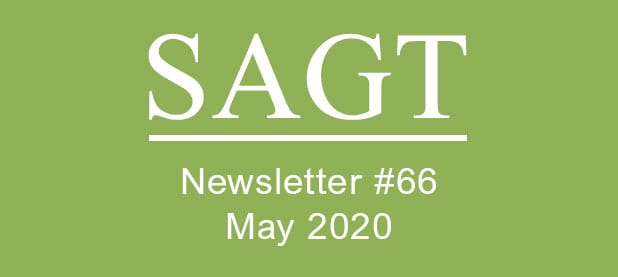
Dear Reader(s)
Welcome to our second newsletter since the lockdown. Our introduction is slightly different this time as Jeremy has been busy with his Chairman’s report, amongst other things.
Life is continuing in a strange fashion as we all try to adapt to our new situation. Although our movements are restricted, for those with access to the internet there seems to be no lack of suggestions as to how we might spend our time! Otherwise we are enjoying a beautiful Spring with opportunities for many to walk out and enjoy it, also to use the time for painting or writing. Most of the major art galleries and museums are offering ‘virtual tours’ of their collections.
Our newsletter reflects some of these interests; Tami has given us a piece about a great painting enthusiast Winston Churchill and the solace he found in painting, Jeremy has given us a wonderful picture of a hare by C.F.Tunnicliffe with his personal responses to it and I have written about Naum Gabo at Tate St Ives.
As you know, one of the casualties of the present situation is that our exhibition ‘eARTh’ at the Brewhouse has had to be cancelled. Whether we will be able to hold the exhibition this year depends on the Brewhouse and how long present restrictions continue. In the meantime, one of our members Zoe Ainsworth Grigg has offered to make a film of people’s work and publish it on YouTube. If SAGT Members would like to send Zoe a photo of their work (up to 3 pieces) she will make a video together with a short biography. It would be similar to Zoe’s website portfolio, with viewing time a little longer. Zoe can be contacted on zoeainsworth@aol.co.uk and her website is https://www.zoeainsworthgriggbooks.com/. Thank you Zoe.
At risk of internet overload I can suggest two art-related links – Philip Mould (of TV’s Fake or Fortune) is offering daily tours of his house on YouTube (https://www.youtube.com/watch?v=AoqTM4IljJM) giving the background art history on his personal collection. I can also recommend The Open University’s ‘OpenLearn’
Programme which offers free courses, short or long on a wide variety of subjects including art and art history (https://www.open.edu/openlearn/free-courses/full-catalogue).
Your committee send you our very best wishes and hope that you and your families will continue to keep well and safe.
Anna Mullett
Painting as a Passion
“Light and colour, peace and hope, will keep painters company to the end of the day.” Winston S. Churchill
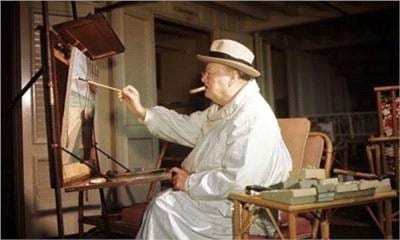
Winston Churchill painting at Miami Beach, FL
My mother loved Churchill and read many of his biographies and autobiographies. Many of my visits would find her with one of his books by her bedside. She found comfort and knowledge from him, not to mention giving him full credit for getting her through the war, when growing up in Central London.
I found myself turning to him, ironically, these few weeks for a different reason, only to find a similar thread. I discovered Churchill’s essay on painting a few years ago, 2016, written in 1932, (my edition 2013). I was re-reading it and it spoke differently to me this time. Churchill’s essay Painting as a Pastime is an essay on the joys of painting-
“Many remedies are suggested for the avoidance of worry and mental overstrain ….” And he continues, “the constant and common element in all the remedies is Change…. To be really happy and really safe, one ought to have at least 2 or 3 hobbies and all must be real.”
He speaks of other things before “painting” for about a quarter of the essay to explain the how and whys. One of the things raised happened to be “the library” and having/reading books. One lovely thought was how he views books as friends and acquaintances. And we should always handle our books even if we do not read them or read them completely. They are our acquaintances, if not all our friends.
He later gets into painting and explains how “painting is a companion with whom one may hope to walk a great part of life’s journey. Age cannot wither her nor custom stale her infinite variety.” Churchill speaks of how happy are the painters, for they shall not be lonely. Light and colour, peace and hope, will keep them company to the end, or almost to the end, of the day.
He finds painting astonishing and enriching. He tells us not “how” to paint but how to get enjoyment from doing it. He calls it “new mental food and exercise”. He also warns not to try to be masters or inspire to masterpieces but be content with the “joy ride in a paint box.”
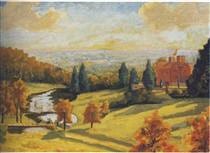
W.S. Churchill View of Chartwell (1938)
Churchill shares his own personal experience and how it was during the long hours in which he had to contemplate the frightful unfolding of the war that painting came to his rescue. And this is where the essay spoke to me in a different way than the previous time. We had not been at “war” then. I felt “this time”, sadly, it might be more appropriate for ourselves.
Churchill goes on to say that like in battle, one needs a plan and to study the achievements of the great captains of the past. This can be applied to painting and when one paints themselves, suddenly you look at previous art differently.
Another point I felt was pertinent; the chief delight that he says comes through trying to paint, is the heightened sense of the observation of Nature. What better time than now.
“Painting is complete as a distraction. I know of nothing which, without exhausting the body, more entirely absorbs the mind, whatever worries of the hour or the threats of the future, once the picture has begun to flow along, there is no room for them in the mental screen.”
If you have not experienced it for yourself before now, I hope you are tempted to seek it out. What better time than now?
Tami Boden-Ellis
Sitting Hare
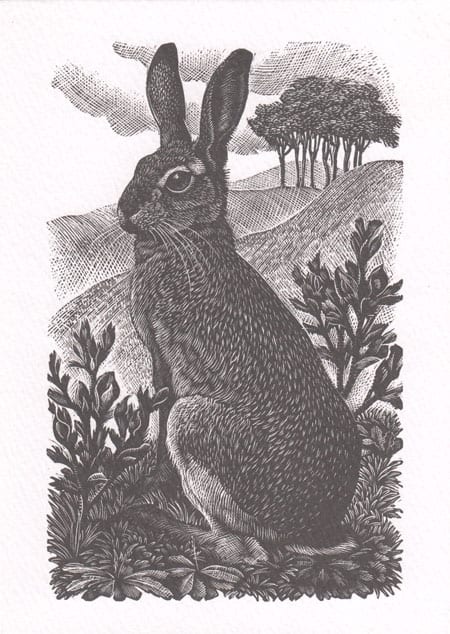
C F Tunnicliffe RA ‘Sitting Hare’ (1949)
I found this old birthday card recently when tidying up. It is a superb drawing of an animal much appreciated by my wife and me. She wears a silver hare badge and responds to hares for their joy, vitality and pugnacity (their boxing). On our late night drive to a farmhouse in the Dordogne last June we caught a hare in the car’s lights sitting transfixed in the middle of a country lane. We were delighted to have such a close up for a few seconds, and took this chance meeting as a welcoming sign, in what turned out to be a very happy family reunion. Tunnicliffe has created a still, alert and attentive sitting hare, half turned towards us. Every line and mark that make up his body, including his whiskers, is lovingly drawn; and the attention to detail within a carefully balanced composition, is such that there is an overall harmony of light and shade, with space for our eyes to move up and down, and so take in the whole as well as the parts. I don’t usually get so excited by engravings but this one thrills me. It causes something within me to match those two ears, so pricked, with some cloud passing behind them.
Jeremy Harvey
Naum Gabo at Tate St Ives
Just before the present lockdown came into force I was fortunate to go with a friend on a day trip to St Ives to visit the Tate. St Ives was looking beautiful with blue skies and rough seas. The Tate itself had greatly expanded since I last saw it, now with new galleries which were celebrating St Ives and West Country artists and those whom they influenced and vice versa. The main exhibition marked the 100th anniversary of the publication of the Realistic Manifesto (1920) in which Naum Gabo together with his brother Antoine laid out his artistic principles.
Naum Gabo (1890-1977) was born in Russia and originally studied engineering before becoming an artist. Known now as a Constructivist he wanted to present a vision of his time and the future, using geometric and mathematical forms which involved movement, kinetic waves and music. In the Manifesto Gabo stated that ‘space and time are the only forms on which life is built and hence must be constructed’, and intended that his works should reveal themselves through their interior space rather than through form and mass.
Gabo’s concepts are easier to understand if you are looking at his artworks. As you enter this beautifully laid out exhibition the first piece you see is his monumental metal Head no 2 (1916). In this work he demonstrates how volume can be achieved through interlocking planes and light and shade without using solid mass. Another art work near the beginning of the exhibition is a replica of his Kinetic Construction Standing Wave (1919-20), a slender metal rod which when you press the button gives an illusion of space as it vibrates. It was quite mesmerising and merited several button pushes!
Like other Constructivist artists Gabo believed that art should be part of everyday living and he made designs
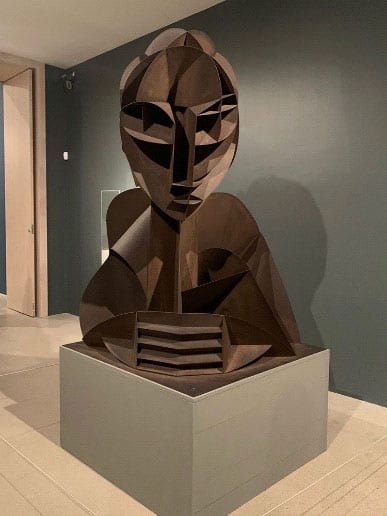
Naum Gabo Head No 2 (1916)
for public buildings, monuments, towers and fountains. Although he used wood and metal and other industrial material he also graduated to plastic which being clear enabled the viewer to see a three dimensional work from a single viewpoint. He designed architecture which would be transparent, animated by the people who would pass through it. He formulated his ideas on a small scale using card which he cut out and glued before making the full-size sculpture. Several of these models, together with his drawings are in the exhibition.
One of the most beautiful artworks in this exhibition is his Linear Construction in
Space no 2 originally conceived in 1949. Made of nylon filaments strung around interlocking planes it is subtle, delicate almost ethereal if that is not too fanciful a word.
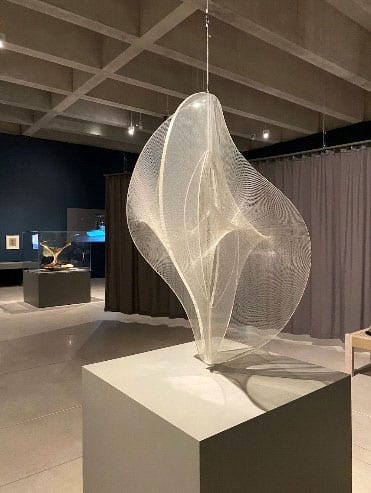
Naum Gabo Linear Construction in space no.2
Gabo’s influence was far reaching. He travelled widely and in 1939 having moved to England he came to live in St Ives at the invitation of Ben Nicholson and Barbara Hepworth, becoming one of the artists who helped establish the town’s international reputation. His influence can be seen in the work of St Ives artists such as John Wells (below).
Gabo believed that art was a force for good and wanted to communicate through his work, in his words, ‘the rhythms and forms of our material and spiritual worlds’. Sadly this wonderful exhibition due to close on May 3rd may not now be seen, one of many casualties in the art world at the moment. On a more positive note the Tate St Ives website states ‘Opens June 1st’ – we can only hope!
Anna Mullett
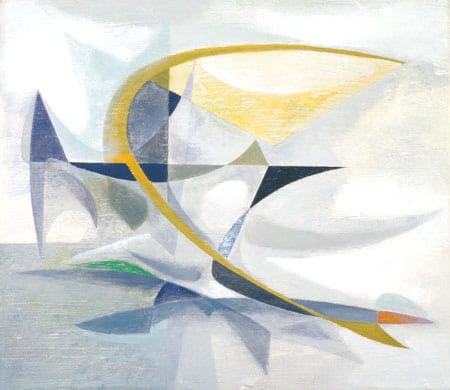
John Wells Sea Bird Forms (1951)
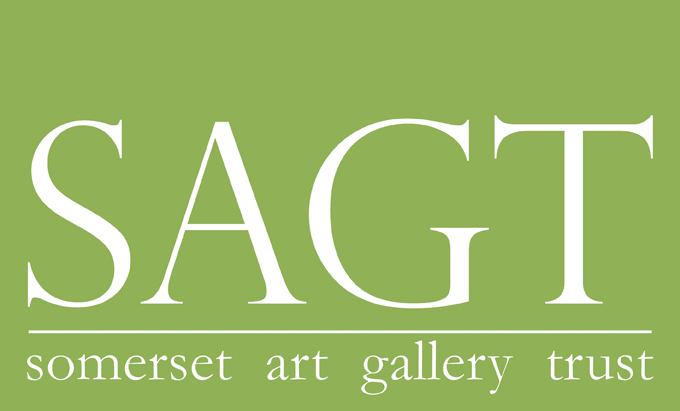
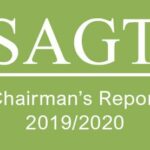
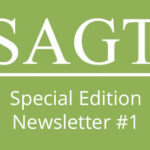
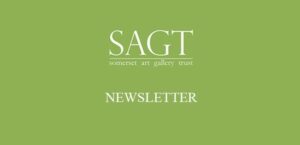
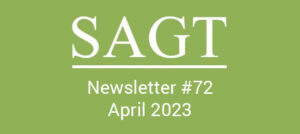
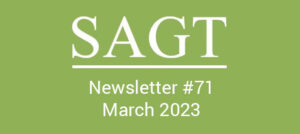
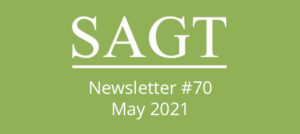
No comment yet, add your voice below!